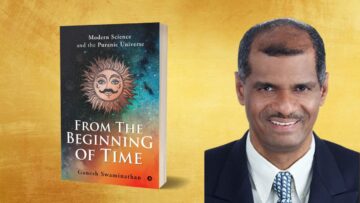Center for Consciousness Studies and Inner Transformation (CCSIT) was formally launched on the 17th of February, 2021.
CCSIT’s offerings are channelled through four verticals :
- Vedanta
- Yogaacharya
- Coaching for Inner transformation
- Conscious Entrepreneurship
CCSIT has Dr. Prasad Kaipa as its Chief Mentor and Chairperson. It is being managed by Directors of its verticals. Hari Kiran is initially heading the Vedanta/ Conscious Entrepreneurship vertical, Vinayachandra the Yogaacharya Vertical and Raghu Ananthanarayanan and Brhm. Sai Sambath are leading the Coaching for Inner Transformation (CIT) vertical.
Since its launch the work done in each of the four verticals is given below :
A. Vedanta:
During the year, land of 4.55 acres near Brahmagiri in the Outskirts of Coimbatore has been purchased for building of an ashram for offering long term courses in Vedanta. The programs at the ashram will be run independently by Swamini Atmaprakashananda. You can read about the announcement here
A collaboration with Chinmaya International Foundation to support 10 long term students of their Vedanta Sadhaka Course has also been initiated.
B. Conscious Entrepreneurship :
Program development for seeker-entrepreneurs as well as successful entreprenuer- seekers is underway.
C. Yogacharya :
Two ideation programs (Discussion Paper and A Panel Discussion ) involving various practioners were conducted for developing the curriculum for a Yogacharya program.
Yogacharya Alliance launch announcement has since been made and preparations are underway to formally inaugurate the Alliance on International Day of Yoga. The alliance will be established as independent trust with a separate governing council and a seed capital contribution by Indic Academy.
Membership of Yogacharya Alliance
There shall be three kinds of membership:
Honorary Membership :
A select few very senior Yoga practitioners will be invited and conferred the title “Yogacharya” in recognition for their yeoman service to the development of Yoga.
Primary Membership:
Practitioners who have completed a 200 hour teacher training program and have a certificate from any recognised body only are eligible for becoming members of the Alliance. Such members also have to sign a “Seekers Pledge” before being accepted as primary members.
Qualified Members:
Members who have completed an advanced teacher training program offered by Indic Academy or any other institution are eligible to appear for the Yogacharya test that will be conducted by the honoury members. This test will be designed and developed by the honorary members.
Yogacharya Foundation Course:
Preparations are underway to launch 6 week residential Yogacharya Foundation Course in August. Students who have completed a 200 hours Teacher Training Program offered and recognised by any other body are eligible for this Foundation Course.
Only students who have completed this foundation course are elegible for the 12 month residential Yogacharya Program proposed to be launched in January 2022.
D. Coaching for Inner Transformation
Applied Indic Psychology Summit ( AIP )
We organised an initial two-day Summit dialogue (13th and 14th Feb at IISC Bangalore) on Applied Indic Psychology because we saw a large lacuna in the way applied behavioural sciences is practiced in India. The field of Applied Behaviour as it is practiced in India is very highly influenced by western ideas. Since it is assumed that these ideas are universal, the influence of these on leadership and executive behaviour is very high. While the western thinkers in the field of psychology have constantly borrowed and digested eastern ideas, the bulk of the practitioners in India simply swallow the western ways.
The area of coaching and facilitation has many people who would like to be more anchored in the Indian thought, but due to the market pressures as well as the paucity of credible institutions to learn from they flock to western certification processes. The Academic space in India has not been very favourable to Indian Psychology. Traditional scholars with a deep understanding of Indic wisdom are not conversant with the language of psychology and therefore unable to contribute to the field. Creating a platform that falls at the intersection of these three (namely, the current practice of coaching/ facilitation, academia, and traditional scholarship) is important. This platform can encourage serious study and certification as well as support action research using Indian frames of thinking.
The Summit explored these ideas and came out with a set of foundational principles that will become the basis for sustained action over the long term.
Recommendations of the Summit:
The members of the Summit came to the conclusion that we need to develop new lenses through to view the field of mind sciences as we go forward. The Summit defined the ongoing effort as the seeding of a place where people with different ideas of India and with different sources of knowledge can come together and develop a body of knowledge and practice of mind sciences deeply rooted in the Indic Wisdom.
Developing an institutional framework is critical. This institution ought to establish a practice and a system of internship of practical experience and supervision so that many people learn the framework and apply it in various contexts. We need continuity, transition therefore, the group decided to adopt the values that form the underpinning of the Yoga Sutra-s namely, commitment to duHkhanivarana, ahimsa, Ananda and satya.
Given below are some of the key ideas that were dialogued.
• The dominance of western world-view is disturbing, how can we develop an alternative based on our genius?
-
- We need to do a lot more research and dialogue; many are not aware enough of the the richness of our tradition. They are not aware of the dangers of adopting ideas without interrogating them through a lens that is meaningful to us.
- There is an emerging pride, but there is also a deep search for identities; regional, caste, religious and so on. This has positive and negative possibilities.
• Much of our knowledge is called religious or spiritual, this a problem since most of these texts have great treasures of linguistics, mathematics, science, technology, Ayurveda and so on. Many ideas on the mind sciences are found in texts like the Bhagavad Gita, the Upanishads and the Yoga Sutra. Buddhist, Jain, Charuvaka and other Indic traditions also have much to contribute to the mind sciences. Many seminal ideas lie scattered in the Purana and Itihasa also.
• In the last 300 years, the intellectual discourse was dominated by the west and was presented as the only model, but now the colonized countries that may not have had the rigour to confront the domination are not quite willing to accept universalisation of western world views and models.
• As greater confidence is building up in other societies alternative models are being explored
Examining what is Indian?
Civilizational predispositions are being talked about in the context of old times and old texts. We have to ground the discourse in the current context. A central question to explore is “who is the Indian today?”
-
- What are our identities today? What are our aspirations?
- Most Indians belong to linguistic, local, community, and so on, these are sectoral identities; this was seen as a threat to the “national identity” at the turn of the Independence, therefore an abstract idea of India was pushed; there is a conflict between these two anchors of identity;
- Emotionally what does being Indian mean?
- Indian-ness is not in tangible externals
There is a common thread of Indianness that cuts across in the way it is lived amongst Indians. In the research done by Ashok Malhotra he has discovered a commonality in the way people look at themselves and live their lives across generations. These have not changed – the basic configuration of the identity has remained the same:
-
- Shifts are more superficial than real – there has been no significant shift in the basic configuration of the Indian mind
- A certain preoccupation with a relational orientation
- A certain orientation to engage with the immediate context
- A certain ambivalence to engage with the material world – irrespective of the religion you belong to
- The idea that one comes with a clean slate (Atma) is a faith that is commonly held
- Deep faith in life
- Preoccupation with purity and pollution at a personal level.
This body that is being proposed ought to examine if we have a collective idea of what is Indianness? Can have multiple facets? Can we develop some overarching ideas without dogmatizing it?
The current discourse that we hear hinges around the pulls and pushes created by organized dogma, market forces, communal forces and political manoeuvring. Therefore, it is dominated by issues of aggression and victimhood and we are not able to come to a sense of harmony. Whereas beneath all these chaos we also have a sense of convergence, an sense of cultural continuity which may allow us to harmonize the polarities within us, that’s the space we need to nurture. What are some of the Knowledge systems that will enable this coherence to emerge?
The way forward
The deliberations then focused on the context in which we find ourselves. What emerged was that all cultures are changing and asking identity questions. Existing models in almost all the key fields of human endeavour are inadequate. There are signs of failure in every field; All paradigms in question; Markets everywhere are displacing the cultural heritage; All futures are global futures, current paradigms are fragmented and bounded. It is here that a lot of our wisdom could be of great help.
Some of the fundamental concepts of the Indic worldview offer a more hopeful and holistic set of possibilities: Firstly, the Indic world view defines Consciousness at its centre; Second is simultaneity and inclusion; Third is Existential relatedness and we are co-related and connected, not individuals on an island; Fourth is androgeny that goes beyond masculine or feminine; Fifth is that Indic worldview is always contextual.
If we can develop, lenses, frameworks and theories of self, group, organization and society based on these concepts, it will make a big difference to the state of affairs we encounter. Our intent is to take the journey of reclaiming our identity that began with independence to its completion: Swaraj to Samraj. The primary task of the AIP ought to be to develop a theory and practice grounded in Indic ways that provides a lenses and frameworks through which to understand the human psyche and enable it to unfold.
Some of the key issues that confront us in this endeavour are cantered around the fact that the Indian Identity is not only a composed of multiple threads many of which are neither coherent nor convergent, but also that there are historical wounds to the identity of the majority that needs to be addressed. The lenses and frameworks we develop has to confront this reality and hold in balance and honour the plurality of the culture. The processes whereby a double consciousness is created and the ways of the oppressor are internalised at the cost of one’s own heritage have their roots in the long periods of colonization that India has seen. The issue that we must acknowledge is that these processes continue to haunt us. They are evident in the dichotomy between the ideas of man and the world that underpin the socialization processes within the family and the ideas of man and the world that dominate the official discourse. The extent of erosion of the traditional wisdom traditions makes the access to authentic parampara traditions difficult.
The evidence of collective and personal trauma is alive in explicit and implicit ways in many spaces. But, the ways to acknowledge and work through this trauma don’t seem to exist. It will be the endeavour of the AIP to develop ways that are Indic and healing of this trauma. Safe spaces for dialogue are rare, and the Indic form of these spaces where deep dialogue and discovery of svadharma happen are all but forgotten. The AIP will reawaken the flame and continuity of “sakala sahrudaya samvAda” (resonant dialogue) as a way to heal, reclaim and replenish our identity.
What is Indic Knowledge?
The summit deliberated on what would constitute Indic Knowledge. It started with stating that Indic is not Indian (as a geographical space), but having characteristics of Indian-ness. The task of AIP therefore is to develop lenses to view and interrogate knowledge systems with particular emphasis on the human psyche that reflect the essence of Indianness:
Indic as a framework or a lens and its recursiveness is very meaningful. Indic does not have to be only from the Indian tradition but it can also be lens – how we feel, think, and act. While delving into Indic Knowledge systems we have to understand the various strands like Shruti and Smirti, Vedic and non-Vedic, practice centric and shastraic and so on.
How do we balance the discourse? What are the values will ground the enquiry without binding it? For example, the study of Yoga is a very promising area but when one looks at yoga through the current colonized lens it gets caught with two ends of its wide range of practice: just Asana, & prANAyAma or the other extreme namely, the esoteric realms. This avoids the difficult space of transforming the mind, this is the area of Indic Psychology, the antaranga sAdhana, the primary area of our interest.
The importance of an Indic methodology
The work of AIP has to focus on methodology. It is important to bring in Self-reflection and subjective experiences into the process of validation. Indic ways of validation like Tantra Yukti that has an extensive methodology connected with validation have to be embraced.
It was also decided that the cause of Applied Indic Psychology would be best served if Coaching for Inner Transformation (CIT) were to keep Coaching and Mentoring as its central focus.
Proposed offerings by CIT
CIT undertook a landscape study of the Coaching Profession and Industry worldwide with an additional focus on India and USA during August, September and October 2020. The following inferences and decisions emerged:
-
- CIT would target practicing Executive Coaches and offer Masters programs.
- The curriculum would be founded on Indic Pedagogical Framework comprising Shrimad Bhagavad Gita, Yoga Sutras, Vedic Psychology and the like. Indic Models developed by Sri. Prasad Kaipa, Sri. Raghu Ananthanarayanan and other luminaries rooted in Indic Wisdom and insights will be taught.
- The program will be both residential and non residential and the focus will be to ensure the students undergo inner transformation through authentic teachings and immersive experiences.
- In the long run, CIT would expand its transformational offering to Mid Career Professionals aspiring to become Executive Coaches as well.
CIT is in the midst of designing its first offering “Nurturing the Genius Within” (NGW). NGW Curriculum is based on the Indic Four Energy or Chatur Shakthi Model.
Events :
As a preparation for the same a series of Web-Samvads highlighting the importance of Consciousness for Coaching Practice are planned.
CIT has also submitted a proposal titled Practices for Multi-dimensional Presence for ICF Converge 2021.
Research :
Deep study and research leading to world class publications are also being contemplated. Selection of Research projects for this has been initiated.
Community :
CIT is bringing together a group of accomplished leaders, coaches, mentors, consultants, facilitators, pandits, acharyas, academics and researchers. This collective will focus on blending the most powerful learning from the Indic Wisdom to evolve perspectives, principles and practices for inner transformation. At CIT, each one of us would pool in our unique expertise, enable each other’s inner transformation and extend the transformational experience to our beneficiaries.






